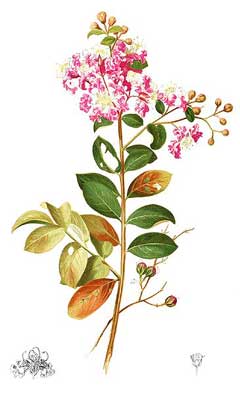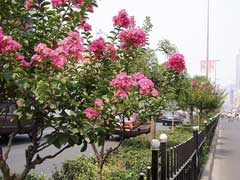 |
|
http://commons.wikimedia.org/wiki/File:Lagerstroemia_indica_Blanco1.207.png |
 |
| http://commons.wikimedia.org/wiki/User:Fanghong |
Translate this page:
Summary
Bloom Color: Lavender, Pink, Purple, Red, White. Main Bloom Time: Early summer, Early fall, Late summer, Late spring, Mid summer. Form: Rounded, Spreading or horizontal, Vase.
Physical Characteristics

 Lagerstroemia is a deciduous Shrub growing to 5 m (16ft) by 5 m (16ft) at a medium rate.
Lagerstroemia is a deciduous Shrub growing to 5 m (16ft) by 5 m (16ft) at a medium rate.
See above for USDA hardiness. It is hardy to UK zone 7. It is in flower from July to September. The species is hermaphrodite (has both male and female organs).
Suitable for: light (sandy), medium (loamy) and heavy (clay) soils, prefers well-drained soil and can grow in nutritionally poor soil. Suitable pH: mildly acid, neutral and basic (mildly alkaline) soils. It cannot grow in the shade. It prefers dry or moist soil.
UK Hardiness Map
US Hardiness Map
Synonyms
Plant Habitats
Edible Uses
References More on Edible Uses
Medicinal Uses
Plants For A Future can not take any responsibility for any adverse effects from the use of plants. Always seek advice from a professional before using a plant medicinally.
The stem bark is febrifuge, stimulant and styptic[218, 240]. The bark, flowers and leaves are considered to be hydrogogue and a drastic purgative[240]. A paste of the flowers is applied externally to cuts and wounds[272]. The root is astringent, detoxicant and diuretic[147, 218]. A decoction of the flowers is used in the treatment of colds[218].
References More on Medicinal Uses
The Bookshop: Edible Plant Books
Our Latest books on Perennial Plants For Food Forests and Permaculture Gardens in paperback or digital formats.

Edible Tropical Plants
Food Forest Plants for Hotter Conditions: 250+ Plants For Tropical Food Forests & Permaculture Gardens.
More

Edible Temperate Plants
Plants for Your Food Forest: 500 Plants for Temperate Food Forests & Permaculture Gardens.
More

More Books
PFAF have eight books available in paperback and digital formats. Browse the shop for more information.
Shop Now
Other Uses
Wood - hard. A useful timber[146].
Special Uses
References More on Other Uses
Cultivation details
Landscape Uses:Border, Container, Massing, Pollard, Standard, Specimen, Street tree. Succeeds in most well-drained soils in a sunny sheltered position[184, 200]. Succeeds in a hot dry position. Succeeds in soils low in nutrients[200]. Dislikes very alkaline soils[202]. Dormant plants are hardy to about -10°c if the wood is well ripened[184]. They require very hot and humid summers and preferably the protection of a south facing wall if they are to flower in Britain[182, 260]. Plants are hardy in a very sunny position in southern England but they only flower in consistently warm summers[11]. Plants are much hardier when the wood is thoroughly ripened by the sun[166, 200]. A very ornamental plant[1], there are many named varieties[200]. Flowers are produced in broad panicles on the tips of the current years growth[219]. Any pruning is best carried out in the spring in order to encourage new growth[219]. Young plants grow fairly quickly and will often flower in their first year after planting out[219]. Plants do not transplant well and should be moved with a large rootball[200]. This species is notably resistant to honey fungus[200]. Special Features:
Not North American native, Blooms are very showy.
References Carbon Farming Information and Carbon Sequestration Information
Temperature Converter
Type a value in the Celsius field to convert the value to Fahrenheit:
Fahrenheit:
The PFAF Bookshop
Plants For A Future have a number of books available in paperback and digital form. Book titles include Edible Plants, Edible Perennials, Edible Trees,Edible Shrubs, Woodland Gardening, and Temperate Food Forest Plants. Our new book is Food Forest Plants For Hotter Conditions (Tropical and Sub-Tropical).
Shop Now
Plant Propagation
Seed - best sown as soon as it is ripe in the autumn in a greenhouse[78]. Another report says to sow spring in a greenhouse[200]. When they are large enough to handle, prick the seedlings out into individual pots and grow them on in the greenhouse for at least their first winter. Plant them out into their permanent positions in late spring or early summer, after the last expected frosts. Cuttings of half-ripe wood, 5 - 8cm with a heel, July/August in a frame. Fair to good percentage[78]. Cuttings of mature wood in the winter in a frame[200]. Root cuttings 4cm long in December. High percentage[78].
Other Names
If available other names are mentioned here
Native Range
TEMPERATE ASIA: China (Anhui Sheng, Fujian Sheng, Guangdong Sheng, Guangxi Zhuangzu Zizhiqu, Guizhou Sheng, Hainan Sheng, Henan Sheng, Hubei Sheng, Hunan Sheng, Jiangsu Sheng, Jiangxi Sheng, Shaanxi Sheng, Shandong Sheng, Sichuan Sheng, Yunnan Sheng, Zhejiang Sheng), Taiwan TROPICAL ASIA: Cambodia, Laos, Thailand, Vietnam
Weed Potential
Right plant wrong place. We are currently updating this section.
Please note that a plant may be invasive in one area but may not in your area so it's worth checking.
Conservation Status
IUCN Red List of Threatened Plants Status :

Growth: S = slow M = medium F = fast. Soil: L = light (sandy) M = medium H = heavy (clay). pH: A = acid N = neutral B = basic (alkaline). Shade: F = full shade S = semi-shade N = no shade. Moisture: D = dry M = Moist We = wet Wa = water.
Now available:
Food Forest Plants for Mediterranean Conditions
350+ Perennial Plants For Mediterranean and Drier Food Forests and Permaculture Gardens.
[Paperback and eBook]
This is the third in Plants For A Future's series of plant guides for food forests tailored to
specific climate zones. Following volumes on temperate and tropical ecosystems, this book focuses
on species suited to Mediterranean conditions—regions with hot, dry summers and cool, wet winters,
often facing the added challenge of climate change.
Read More
Expert comment
Author
L.
Botanical References
11200
Links / References
For a list of references used on this page please go here
Readers comment
| Add a comment |
|
If you have important information about this plant that may help other users please add a comment or link below. Only comments or links that are felt to be directly relevant to a plant will be included. If you think a comment/link or information contained on this page is inaccurate or misleading we would welcome your feedback at [email protected]. If you have questions about a plant please use the Forum on this website as we do not have the resources to answer questions ourselves.
* Please note: the comments by website users are not necessarily those held by PFAF and may give misleading or inaccurate information.
To leave a comment please Register or login here All comments need to be approved so will not appear immediately.
|
|